Of all the SEO goals you can set for a piece of content, the featured snippet may be the most elusive. You have to create both:
- Optimized content that earns a #1 ranking for your search keyword
- A piece of copy that Google sees as valuable enough to feature
With so much competition out there, featured Google snippets can feel like an impossible goal. However, there are plenty of SEO strategies that can improve your chances.
In this article, I’ll show you how to get featured snippets for your content. While there are no guarantees, these tactics will make it more likely for Google to feature your content as a search snippet, driving more traffic to your site.
What is a Featured Snippet?
A featured snippet is a Google search result that provides a short answer to the user’s search query, in addition to the link to that answer’s source. Featured snippets are sometimes called “answer boxes.”
Here’s a featured snippet example that I found by Googling “featured snippet”:
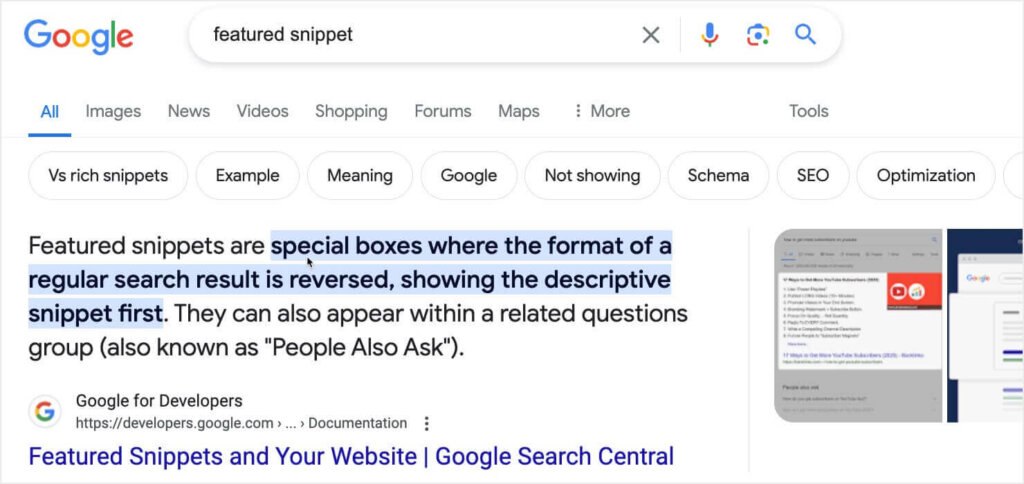

This brief definition is at the very top of the SERP (search engine results page). Google bolds the most important part of the definition and highlights it in blue. The URL and linked title tag are listed below the snippet.
This answer box draws the eye of searchers, hugely increasing the chance that they’ll click on that search result.
In fact, a study from the digital agency Tallwave found that featured snippets boost click-through rate (CTR) by a whopping 859%, from 2.7% to 25.9%.
Types and Examples of Featured Snippets
I’m going to cover for 4 most common types of featured snippets and provide an example of each:
- Paragraph snippets
- List snippets (both numbered and bulleted)
- Table snippets
- Video snippets
Of these, paragraph snippets are by far the most common, with about 70% of search snippets falling into this type.


Lists are the next most common, with table and video being fairly rare.
1. Paragraph Snippets
For this type of featured snippet, Google uses text from the source page to provide an answer to the searcher’s question immediately.
For example, here’s an answer box we earned for our OptinMonster blog. Users who searched for “email subject line” saw this definition, which was pulled from our post on 184 Email Subject Lines And Why They Work.
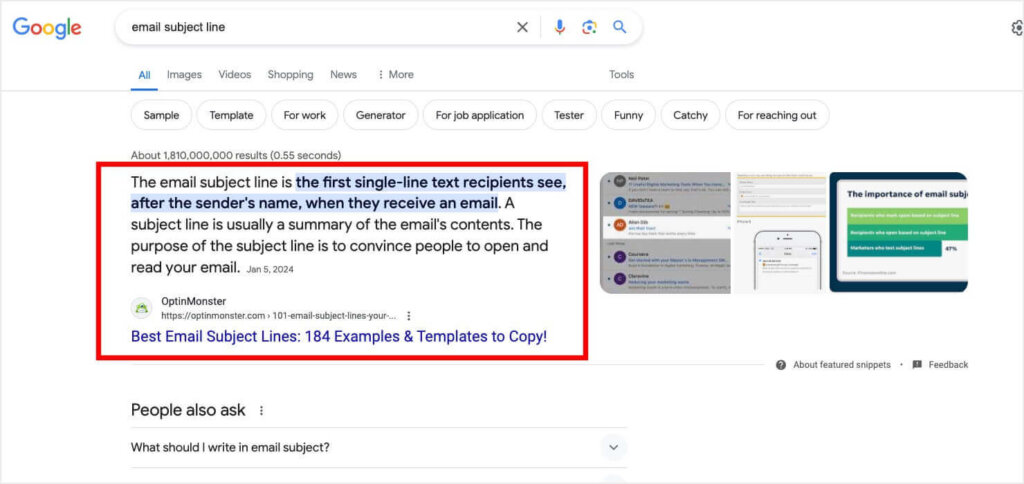

This article is one of the highest-traffic posts on our blog due to search volume, our consistently high ranking, and the fact that we often have the Google featured snippet.
How did we achieve this snippet?
- By creating a high-quality, helpful post
- By optimizing the post for the top SEO ranking factors
- By including a concise and precise explanation for the search term
- By making it easy for Google to find that definition
This screenshot shows the blog copy that the featured snippet was pulled from:


We wrote our copy as a direct answer to the question in our subheading. We followed this formula:
“What Is X? X is . . . “
By formatting our definition in this way, Google can easily find it and pull it for a featured snippet.
2. List Featured Snippets
List snippets come in 2 flavors: numbers and bullets. They often feature steps, tips, or instructions.
Here’s an example of a numbered list snippet for the search term “tips for email copywriting”:
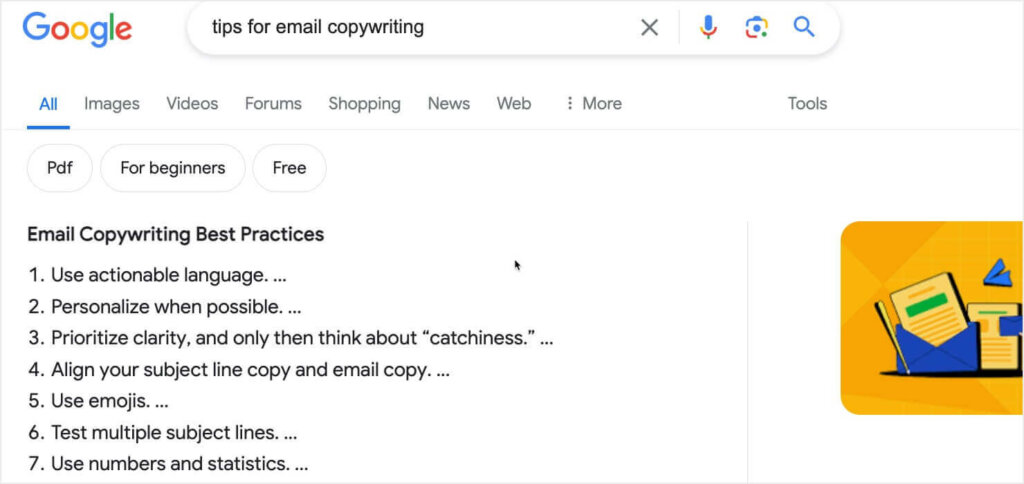

This exact list doesn’t exist within the HubSpot article. Instead, Google pulled the list from the article’s subheadings.
List snippets can also take the form of numbered instructions, like in this recipe result:
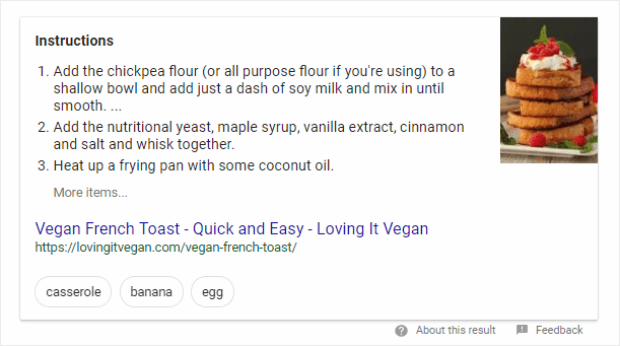

Bulleted snippets will come up when content doesn’t use numbers, and the order doesn’t really matter.
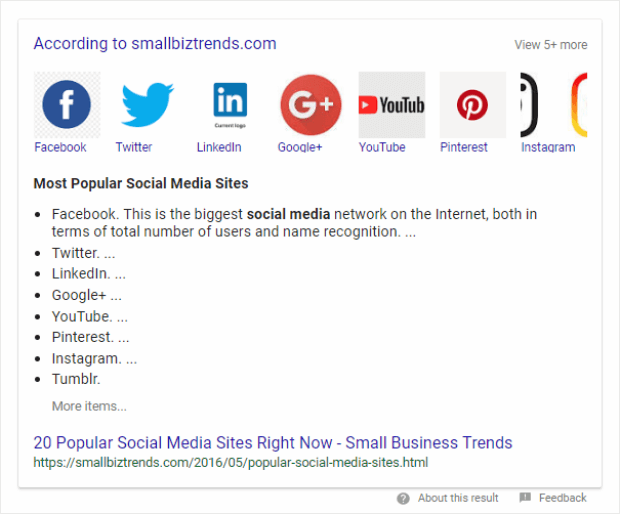

If your list doesn’t fit within the answer box, you’ll see “More items” link. This signals to the searcher that there is more information available and could easily lead to increased click-through rates!
3. Table Featured Snippets
Table snippets show collections of data in a clear table format.
Here’s a table featured snippet example that I found by Googling “American to metric conversion”:


This example shows the potential pitfalls of table snippets, as Google has actually incorrectly pulled the data. After all, 1 inch does not convert to 4.929 ml. In this case, Google pulled data from multiple side-by-side tables in the original article.
Here’s an example of a more successful table snippet, which provides correct information:


In both of these cases, the original article included tables that Google could pull data from. As with the “More items” link for list snippets, Google will feature a “More rows” link for longer tables.
4. Video Featured Snippets
Google often prioritizes video results for how-to search queries, and that can include the occasional video featured snippet, where the video can be played right on the SERP page. In this example, Google highlights the 90-second clip that’s most relevant to the user’s search.
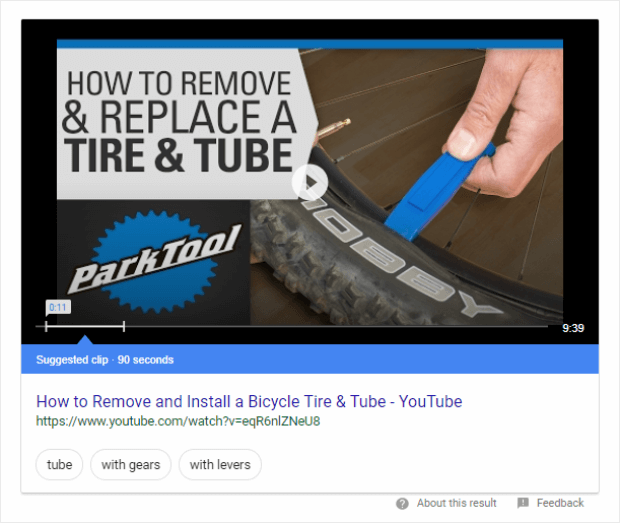

Video snippets are always pulled from YouTube, as that platform is owned by Google. Despite the fact that there are 14 billion videos on YouTube, video snippets are quite rare.
What’s more common these days is getting a rich search result, like the one below that features key moments in the video:


You can also win a spot in a list of video results:


In order to win video featured snippets and rich results, you should:
- Organize your content in a step-by-step format
- Upload a script for the video’s closed captions
- Optimize the video’s description using long-tail keywords
- Add timestamped chapters to your YouTube videos
- Use a video schema markup on any videos you embed on your website
How to Get Featured Snippets (4 Proven Tips)
Featured snippets are challenging to earn. However, here are 4 actionable tips to help you learn how to get a featured snippet for your chosen keyword.
- Include Concise Explanations
- Help Google Find Your Snippet With Headings & Questions
- Use Data-Driven, Well-Structured Content
- Always Consider Search Intent
1. Include Concise Explanations
While it’s no secret that Google favors long-form content, you need to be precise when providing your definitions and explanations.
The average length of a paragraph snippet is 40-50 words, so keep that in mind when you’re writing the content that you’re specifically trying to get recognized as a featured snippet.
After that initial brief explanation, you can go into more detail with examples and use cases.
2. Help Google Find Your Snippet With Headings & Questions
Once you’ve written a perfect and concise answer for a search query, you need to make sure Google can find it. You can do that through your subheadings and by including direct questions in your content.
Here’s a featured snippet example for the search term “accounts payable vs. receivable.”
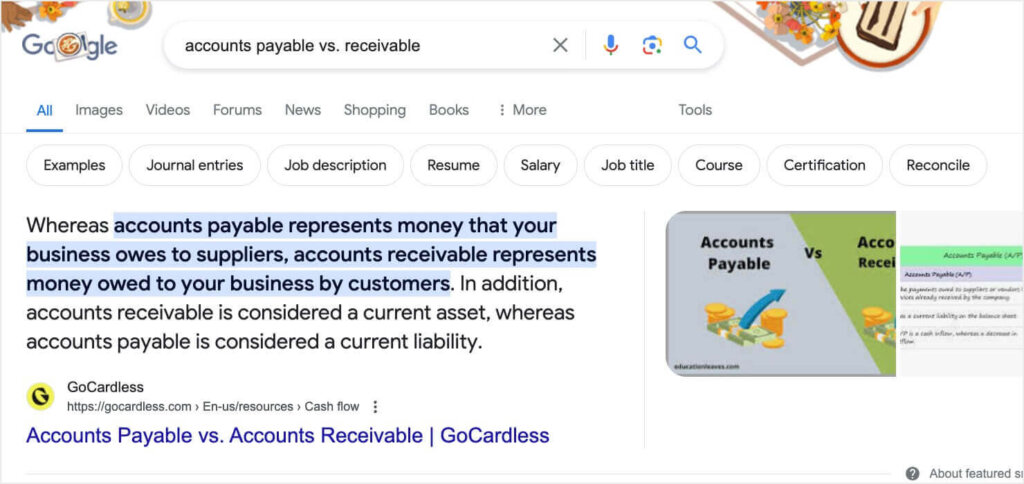

I clicked on that result so I could see how GoCardless had presented their snippet text:


GoCardless included both a subheading and a question to make it easy for Google to recognize that their copy would make a good featured snippet.
3. Use Data-Driven, Well-Structured Content
Google loves lists, numbers, and steps that are well-organized, and it picks up on standard formatting tags like <table>, <ol>, and <ul>.
Here are a few tips for getting list and table snippets:
- Number your subheadings: If your content includes steps, instructions, or best-of lists, create numbered subheadings that Google can easily recognize. Also, place those subheadings under a descriptive main heading. For instance, you might have an H2 heading that reads “How to Start a Butterfly Garden.” Your H3s under that heading might be, “1. Pick a Sunny Location,” “2. Till and Fertilize Your Soil,” and so on.
- Include tables of contents: A table of contents that includes all your headings and subheadings also helps Google find lists to pull for featured snippets.
- Summarize your content in a table: Your article might cover a topic such as the average income in top cities. If you add a table that summarizes the data in your article, Google will be more likely to use it as a featured snippet.
- Use bulleted and numbered lists: Always look for information that would be best presented as a bulleted list. Not only do lists make your content easier to scan online, but helpful lists are often used for Google snippets.
Remember that your ultimate goal is to be the best at answering the searcher’s question, so your answer should always contain well-researched and factual information.
4. Always Consider Search Intent
When implementing any of the above strategies, you have to ask the question: What information is the searcher looking for?
Search intent, also called keyword intent, is the ultimate goal of the searcher. Google uses search intent to determine which results to display for a given search query.
If you want to get an answer box for a specific topic, Google some of the top related keywords to see what Google believes the intent is for those queries. Then, try to make your content more concise, precise, and helpful than the competition. This keyword research will help you earn higher search rankings, get more answer boxes, and drive more traffic to your site.
Featured Snippet FAQs
1. Are featured snippets good for SEO?
Yes, featured snippets are excellent for SEO. They place your content at the top of search engine results pages (SERPs), significantly increasing your visibility and click-through rates (CTR). Featured snippets drive more traffic to your site, as users are drawn to concise and relevant information.
2. What is the difference between featured snippets and rich snippets?
Featured snippets provide a direct answer to a user’s query at the top of the SERP, above the regular search results. They often include a summary of the content pulled directly from a web page, along with a link to the source. Rich snippets, on the other hand, are enhanced search results that include information such as ratings, reviews, or product details. Rich snippets make use of structured data markup, also called schema markup, to provide this extra context within the search results.
3. What tools can I use to find featured snippet opportunities?
There are several tools you can use to identify answer box opportunities:
- LowFruits: Helps you find low-competition keywords to optimize your chance of getting high rankings and Google snippets.
- Semrush: Offers a powerful feature for finding keywords that trigger featured snippets and can help you identify gaps in your content.
- Ahrefs: Provides insights into which keywords your competitors are ranking for in featured snippets and how you can optimize your content to capture those spots.
- Moz: Helps you track your rankings and find potential featured snippet opportunities by analyzing the SERPs.
- Answer The Public: Lets you discover common questions and search queries related to your topic, which can be used to optimize your content for featured snippets.
4. Can I lose a featured snippet once I have it?
Yes, it’s possible to lose a featured snippet. You may lose it to a competitor that has optimized its content, or Google might update its algorithms.
5. How often should I update my content to maintain featured snippets?
Google favors fresh and relevant content, so you should revisit your posts every few months to add new information, update statistics, and improve readability. Additionally, keep an eye on changes in search intent and your competitor’s content, so you can find opportunities to re-optimize your pages.
6: How do featured snippets impact voice search?
Featured snippets play a significant role in voice search. When users make voice queries, virtual assistants like Google Assistant often read out the featured snippet as the answer. Because of this functionality, optimizing your content for featured snippets can increase your visibility and engagement in voice search results.
Level Up Your SEO With Featured Snippets
When you optimize your content for Google featured snippets, you can catch the attention of more users, improve your search rankings and traffic, and demonstrate your authority in your niche.
If you’re interested in more ways to boost your rankings, check out these resources:
Of course, driving traffic to your site is only the first step. Next, you need to focus on converting that traffic into subscribers, sales, and revenue.
That’s where OptinMonster comes in!
You can use our popups, floating bars, and other onsite marketing campaigns to show your best offers to the right people at just the right time.
Disclosure: Our content is reader-supported. This means if you click on some of our links, then we may earn a commission. We only recommend products that we believe will add value to our readers.


